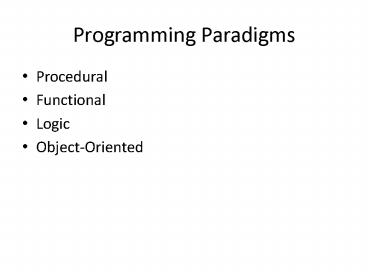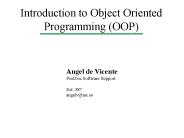Programming Paradigms - PowerPoint PPT Presentation
1 / 30
Title:
Programming Paradigms
Description:
= 3 Paradigm vs Language Imperative Style tsum := 0; i := 0; while (i – PowerPoint PPT presentation
Number of Views:127
Avg rating:3.0/5.0
Title: Programming Paradigms
1
Programming Paradigms
- Procedural
- Functional
- Logic
- Object-Oriented
2
Specifying the WHAT
- Describe the Inputs
- Specific values
- Properties
- Describe the Outputs (as above)
- Describe the Relationships Between I x O
- As a possibly infinite table
- Equations and other predicates between input and
output expressions - For a given input, output may not be unique
3
Specifying the HOW
- Describe the Inputs
- Specific values
- Properties
- Describe HOW the Outputs are produced
- Models of existing computers
- Program State
- Control Flow
- A Few Abstractions
- Block Structure
- Recursion via a Stack
4
Procedural programming
- Describes the details of HOW the results are
to be obtained, in terms of the underlying
machine model. - Describes computation in terms of
- Statements that change a program state
- Explicit control flow
- Synonyms
- Imperative programming
- Operational
- Fortran, C,
- Abstractions of typical machines
- Control Flow Encapsulation
- Control Structures
- Procedures
- No return values
- Functions
- Return one or more values
- Recursion via stack
5
Procedural Programming State
- Program State
- Collection of Variables and their values
- Contents of variables change
- Expressions
- Not expected to change Program State
- Assignment Statements
- Other Statements
- Side Effects
6
C, C, C, Java
- Abstractions of typical machines
- Control Flow Encapsulation
- Control Structures
- Procedures
- No return values
- Functions
- Return one or more values
- Recursion via stack
- Better Data Type support
7
Illustrative Example
- Expression (to be computed) a b c
- Recipe for Computation
- Account for machine limitations
- Intermediate Location
- T a b T T c
- Accumulator Machine
- Load a Add b Add c
- Stack Machine
- Push a Push b Add Push c Add
8
Declarative Programming
- Specifies WHAT is to be computed abstractly
- Expresses the logic of a computation without
describing its control flow - Declarative languages include
- logic programming, and
- functional programming.
- often defined as any style of programming that is
not imperative.
9
Imperative vs Non-Imperative
- Functional/Logic style clearly separates WHAT
aspects of a program (programmers
responsibility) from the HOW aspects
(implementation decisions). - An Imperative program contains both the
specification and the implementation details,
inseparably inter-twined.
10
Procedural vs Functional
- Program a sequence of instructions for a von
Neumann m/c. - Computation by instruction execution.
- Iteration.
- Modifiable or updatable variables..
- Program a collection of function definitions
(m/c independent). - Computation by term rewriting.
- Recursion.
- Assign-only-once variables.
11
Functional Style Illustration
- Definition Equations
- sumto(0) 0
- sumto(n) n sumto(n-1)
- Computation Substitution and Replacement
- sumto(2) 2 sumto (2-1) 2 sumto(1)
- 2 1 sumto(1-1) 2 1 sumto(0)
- 2 1 0
- 3
12
Paradigm vs Language
- Imperative Style
- Functional Style
- tsum 0
- i 0
- while (i lt n) do
- i i 1
- tsum tsum I
- od
- Storage efficient
- func sumto(n int) int
- if n 0
- then 0
- else n sumto(n-1)
- fi
- endfunc
- No Side-effect
13
Bridging the Gap
- Imperative is not always faster, or more memory
efficient than functional. - E.g., tail recursive programs can be
automatically translated into equivalent
while-loops. - func xyz(n int, r int) int
- if n 0
- then r
- else xyz(n-1, nr)
- fi
- endfunc
14
Analogy Styles vs Formalisms
- Iteration
- Tail-Recursion
- General Recursion
- Regular Expression
- Regular Grammar
- Context-free Grammar
15
Logic Programming Paradigm
- edge(a,b).
- edge(a,c).
- edge(c,a).
- path(X,X).
- path(X,Y) - edge(X,Y).
- path(X,Y) - edge(X,Z), path(Z,Y).
16
Logic Programming
- A logic program defines a set of relations.
- This knowledge can be used in various ways by
the interpreter to solve different queries. - In contrast, the programs in other languages
- Make explicit HOW the declarative knowledge is
used to solve the query.
17
Append in Prolog
- append(, L, L).
- append( H T , X, H Y ) -
- append(T, X, Y).
- True statements about append relation.
- Uses pattern matching.
- and stand for empty list and cons
operation.
18
Different Kinds of Queries
- Verification
- append list x list x list
- append(1, 2,3, 1,2,3).
- Concatenation
- append list x list -gt list
- append(1, 2,3, R).
19
More Queries
- Constraint solving
- append list x list -gt list
- append( R, 2,3, 1,2,3).
- append list -gt list x list
- append(A, B, 1,2,3).
- Generation
- append -gt list x list x list
- append(X, Y, Z).
20
Object-Oriented Style
- Programming with Abstract Data Types
- ADTs specify/describe behaviors.
- Basic Program Unit Class
- Implementation of an ADT.
- Abstraction enforced by encapsulation..
- Basic Run-time Unit Object
- Instance of a class.
- Has an associated state.
21
Procedural vs Object-Oriented
- Emphasis on procedural abstraction.
- Top-down design Step-wise refinement.
- Suited for programming in the small.
- Emphasis on data abstraction.
- Bottom-up design Reusable libraries.
- Suited for programming in the large.
22
Integrating Heterogeneous Data
- In C, Pascal, etc., use
- Union Type / Switch Statement
- Variant Record Type / Case Statement
- In C, Java, Eiffel, etc., use
- Abstract Classes / Virtual Functions
- Interfaces and Classes / Dynamic Binding
23
Comparison Figures example
- Data
- Square
- side
- Circle
- radius
- Operation (area)
- Square
- side side
- Circle
- PI radius radius
- Classes
- Square
- side
- area
- ( side side)
- Circle
- radius
- area
- ( PIradiusradius)
24
Adding a new operation
- Data
- ...
- Operation (area)
- Operation (perimeter)
- Square
- 4 side
- Circle
- 2 PI radius
- Classes
- Square
- ...
- perimeter
- ( 4 side)
- Circle
- ...
- perimeter
- ( 2 PI radius)
25
Adding a new data representation
- Data
- ...
- rectangle
- length
- width
- Operation (area)
- ...
- rectangle
- length width
- Classes
- ...
- rectangle
- length
- width
- area
- ( length width)
26
Procedural vs Object-Oriented
- New operations cause additive changes in
procedural style, but require modifications to
all existing class modules in object-oriented
style. - New data representations cause additive changes
in object-oriented style, but require
modifications to all procedure modules.
27
Object-Oriented Concepts
- Data Abstraction (specifies behavior)
- Encapsulation (controls visibility of names)
- Polymorphism (accommodates various
implementations) - Inheritance (facilitates code reuse)
- Modularity (relates to unit of compilation)
28
Example Role of interface in decoupling
- Client
- Determine the number of elements in a collection.
- Suppliers
- Collections Vector, String, List, Set, Array,
etc - Procedural Style
- A client is responsible for invoking appropriate
supplier function for determining the size. - OOP Style
- Suppliers are responsible for conforming to the
standard interface required for exporting the
size functionality to a client.
29
Client in Scheme
- (define (size C)
- (cond
- ( (vector? C) (vector-length C) )
- ( (pair? C) (length C) )
- ( (string? C) (string-length C) )
- ( else size not supported) )))
- (size (vector 1 2 ( 1 2)))
- (size (one two 3))
30
Suppliers and Client in Java
- Interface Collection int size()
- class myVector extends Vector
- implements Collection
- class myString extends String
- implements Collection
- public int size() return length()
- class myArray implements Collection
- int array
- public int size() return array.length
- Collection c new myVector() c.size()































